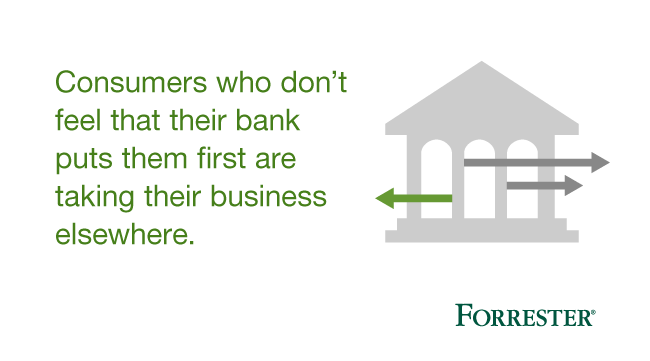The Threat (And Opportunities) Facing Banks Today
Banks serve as the bedrock of the economy, and that bedrock is changing. These changes represent a direct attack against the current banking business model and associated P&Ls. Our Empowered Customer and North America Consumer Technographics data tells us:
- Only 50% of bank customers are willing to keep their existing level of business with their bank.
- Only 59% of bank customers are willing to purchase additional products or services, meaning 41% are not.
- Almost 50% of Progressive Pioneers – the most progressive of our five customer segments representing 25% of consumers in 2016 – indicate they are likely to switch banks in the next year.
- 21% of Progressive Pioneers have closed a bank account in the past 3 years.

To understand the changing landscape, I moderated a panel of experts – Peter Wannemacher, Sam Bishop, and Ted Schadler – to discuss how banks are starting to recognize and react to beacons of change. Here are the key takeaways:
- Customers are on the move: Our Empowered Customer research reveals that 40% of consumers (Progressive Pioneers and Savvy Seekers) have a high willingness and ability to shift spend based on a poor experience. The original belief was this was “millennials being millennials” who have limited buying power. However, our research shows that these consumers also include Gen X and Young Boomers who do have buying power. These two segments constituted 39% of the measured population in 2015 and now constitute 46% of the population – staggering growth of seven points in just one year. That means that we are nearing the tipping point where hyperadoption and hyperabandonment are common behaviors.
- Customer behavior is putting pressure on the bank’s business model and P&L: The changing customer dynamic represents an immediate attack on most banks’ business model; for some it represents an existential threat. Banks have relied on a lifetime loyalty factor, assuming that an initial checking or savings account as a young adult predicts a future buyer of auto loans, mortgages, home equity lines, and investment services. That inferred relationship is dead. This puts pressure on the business model and P&L that depend on a win-them/keep-them relationship.
- Current engagement and experience models are tone deaf: Banks are good at running their businesses and the customer transactions that fuel their business. Unfortunately, that is no longer enough. In our CX Index, we found a 12 point differential between the sector CX benchmark and the extent banks make customers feel valued. There’s a 30 point differential between the industry benchmark and the extent to which bank customers feel their loyalty is rewarded. Simply put, there is an emotional gulf between banks and customers that banks need to address. Many banks have CX initiatives underway – there is a clear mandate to get underneath and address the emotion gap that exacerbates revenue churn and lack of enrichment of other bank offerings.
- Don’t just “appify” current digital practices: Customers across generations are seeking both richer and more personalized digital experiences. Banks have been active in creating digital services and mobile apps to address this need, but in reality, they have been codifying existing practices and not creating new experiences that evoke greater affinity. This has been an extremely positive step in driving up transaction ease and effectiveness but has done little to repair the emotional gap. Layering in everyday content or utilities that adds real value and engagement and makes the bank a valuable part of life is neither natural nor easy, but it is necessary.
- Far-reaching digital transformation is needed – now. The irony is that banks have an extraordinary amount of data and opportunity to bridge the gap; the challenge is converting that data into personalized experiences. This opportunity points at:
The many and old systems of record: Some banks are making major investments (in the billions) in modernizing and federating systems of record to unlock the extraordinary customer data value – giving us a glimpse of what leaders are doing (and what fast followers and others will need to contemplate) to respond to customer dynamics.
New systems of insight: Some banks are making early investments in artificial intelligence and machine learning to intelligently harvest and employ the treasure trove of customer transactional and behavioral data. These banks realize gains now and put in place systems that continuously learn and improve experiences.
New systems of engagement: Banks are faced with a diminishing relationship equity that threatens growth, but the answer is not more human touchpoints for customers increasingly seeking digital engagement. Rather, leveraging investments in systems of record and systems of insight, banks will implement intelligent, predictive services that can deliver just-in-time value to customers – whether that is video chat, conversational interfaces, or intelligent agents – that exploit technology to help form more valuable, stickier relationships.
Banks are at a crossroads where customer behaviors and expectations are threatening the relevance and productivity of banks current business and economic model. Technology helped empower customers and disruptors that threaten banks today; technology can help banks address these threats to reshape and rebuild relationships with customers and create sustainable growth.
For more details on what you can do to stay ahead of your competitors and customers, watch the on-demand webinar, or read more here.